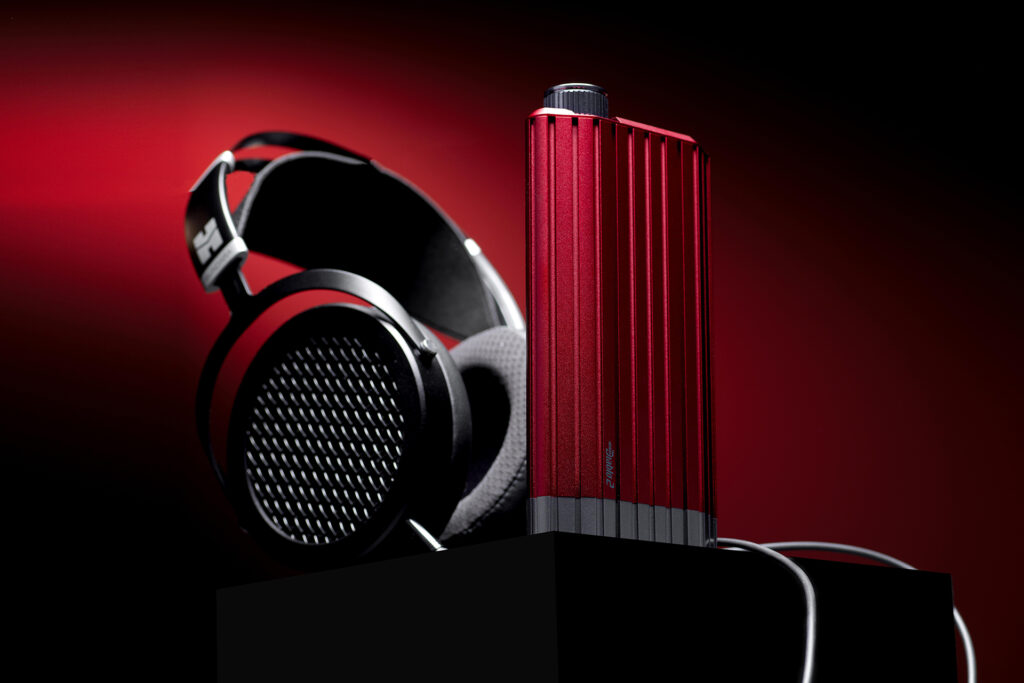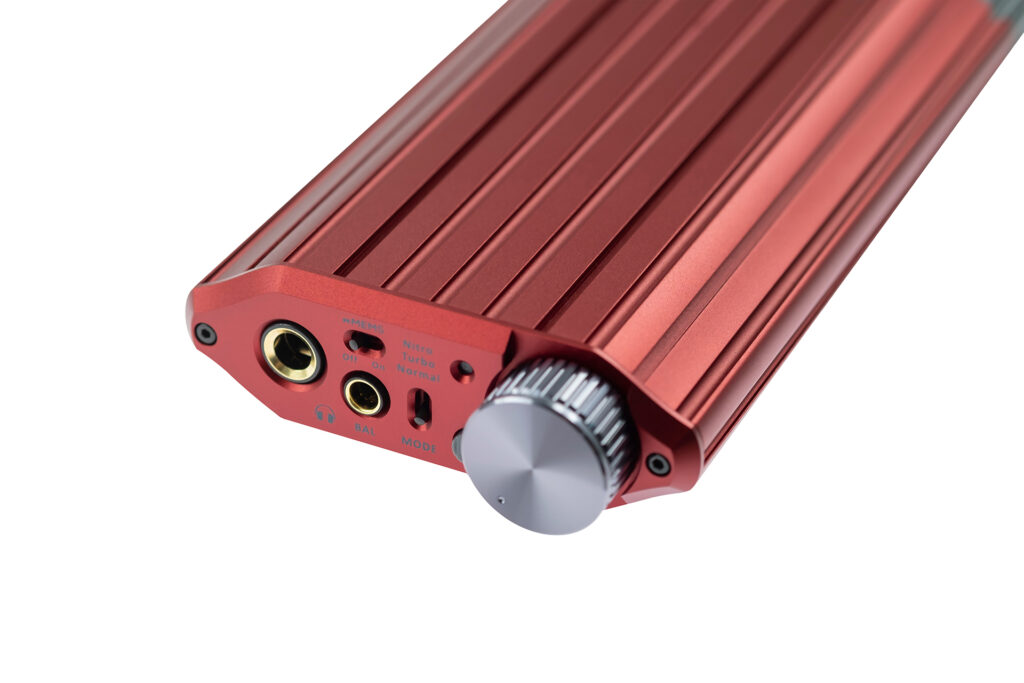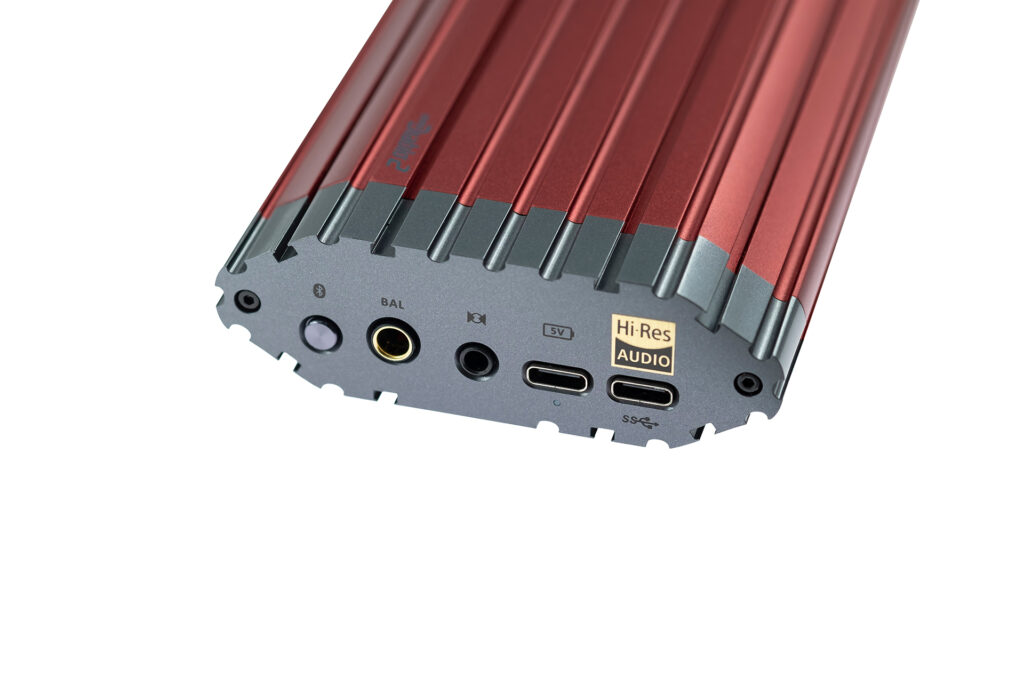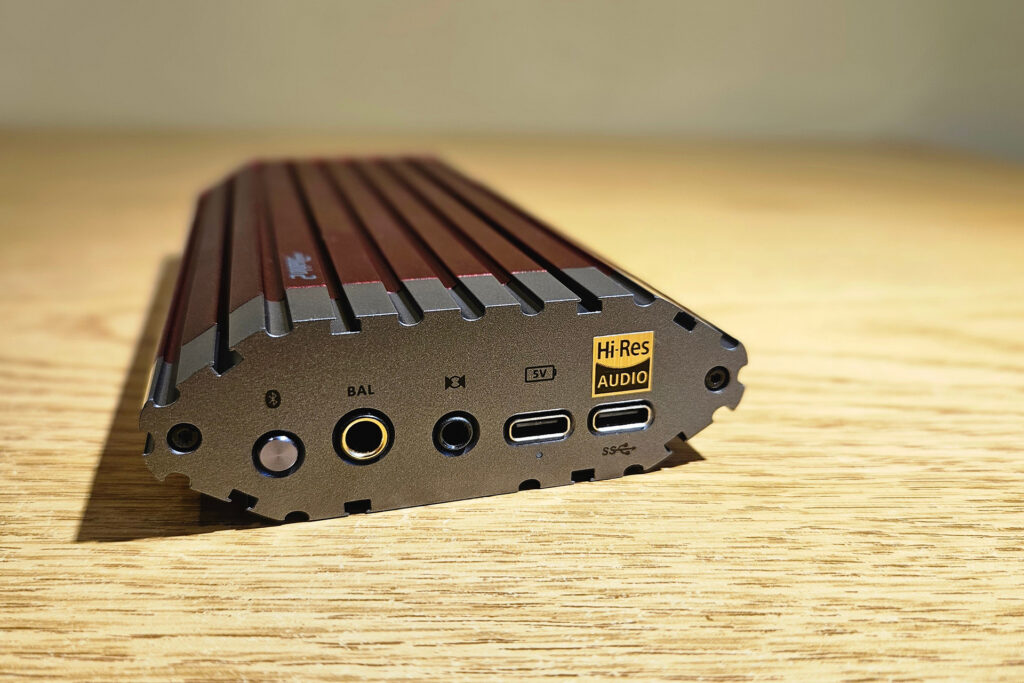Founded in the U.K. in 2012 as a subsidiary of AMR (Audio Music Research), iFi has developed audiophile products that are warmly received by reviewers and owners alike. The company’s lineup focuses primarily on digital-to-analog converters (DACs), headphone amplifiers, and portable audio devices. While the model under review is one of their more premium offerings, most iFi gear is priced at moderate levels, and indeed, high performance at down-to-earth prices makes iFi products go-to choices for many audiophiles.
The iFi iDSD Diablo 2 ($1,299) is a stylish, compact DAC and headphone amp housed in a case of aluminum extrusions, finished in an attractive deep red. Its internal rechargeable battery and compact size (approximately 6.5 by 3.25 by one inches and weighing about one pound) put it into the “portable” category. In the box with the Diablo 2 are a padded case with room for accessories, an iFi iPower 2 charger, plastic “wings” that can serve as a stand, and a variety of cables and adapters. Warranty coverage is one year.
At first glance, I found this to be a versatile and great-sounding product, so let’s examine the many aspects of the Diablo 2, arguably iFi’s flagship portable DAC-headphone amp.

What Makes the iFi Diablo 2 DAC-Headphone Amp Special?
- The sound quality is excellent on the iFi Diablo 2. The Diablo 2 impressed me immediately with its smooth, detailed, and effortless sound. I’ve tried less expensive portable DAC amps, and clearly, the Diablo 2 is in a far superior class.
- With three power modes, the iFi Diablo 2 is designed to drive almost any headphones, while still conserving battery life. The amp is rated at maximum output power of 5,180 mw (over five watts) balanced, and the user can select a power mode to fit the specific phones in use. For high-sensitivity IEMs (in-ear monitors) or efficient headphones, the Normal setting is rated for play time up to 12 hours. For medium-efficiency headphones, there’s Turbo mode (up to nine hours), and for the most power-hungry headphones, Nitro mode (up to six hours).
- The iFi Diablo 2 is rechargeable at any time. The battery is charged through a dedicated USB-C connector on the rear panel, separate from the USB-C digital input, so you can recharge and listen to music at the same time.
- To drive high-sensitivity in-ear monitors, the Diablo 2 includes iFi’s iEMatch circuit. By reducing output level, this feature lessens any background noise and makes the available volume range more suitable when IEMs are in use.
- The latest xMEMS solid-state earphones are no problem for the iFi Diablo 2. An xMEMS mode can be switched on from the front panel, to provide DC bias and equalization for xMEMs earphones. I have yet to experience xMEMS phones, but reportedly they offer excellent transient response, low distortion, and enhanced detail. This is a cutting-edge feature to find in a portable headphone amplifier today.
- The iFi Diablo 2 can handle very high-resolution audio. The unit supports native playback of music formats from MP3 to PCM768, DSD512 and DXD768, along with MQA decoding. I don’t know of any digital music format in widespread use that can’t be decoded by the Diablo 2.
- The iFi Diablo 2 can receive data wirelessly with a full complement of Bluetooth codecs, including the best lossless codec. Using a smartphone or other music source that supports AptX Lossless, HWA/LHDC, or LDAC, you can have the convenience of Bluetooth with little or no sonic penalty. When you connect to a Bluetooth source, the Diablo 2 announces the current codec, which lets you know that you’re getting the best fidelity possible – a really handy feature.
- The lockable volume control and on/off switch prevent accidental battery drain as the unit is being transported. The lock also can protect your ears against an accidental increase in volume.
- The Diablo 2 supports both single-ended and balanced headphones, on 6.35 -m and 4.4-mm jacks, respectively.
Why Should You Care About the iFi Diablo 2 DAC-Headphone Amp?
For portable use, the iFi Diablo DAC-Headphone amp is a strong contender. Although it may be a bit bulky for use during a daily commute or short flight, its compact design, state-of-the-art Bluetooth options, and ability to drive a wide variety of earphones and headphones make it a fine road companion on longer trips. It will perform just as admirably on a home, work, or hotel desktop. Unlike most desktop DAC-headphone amplifiers, though, the Diablo 2’s battery power and compact size let it switch effortlessly between desktop and portable use, and it can do that while providing audiophile sound quality in almost any situation.
If you’re in the market for a well-featured DAC-headphone amp that can adapt to many different uses and sound great in all of them, the Diablo 2 is worthy of strong consideration. It’s a true audiophile product that provides flexibility and versatility without compromising performance.

Some Things You Might Not Like About the iFi Diablo 2 DAC-Headphone Amp
- The control labels are hard to read on the iFi Diablo 2. The small gray labels on a dark red background pose a visual challenge. Owners will learn the switch settings eventually, so they won’t need to squint at labels forever. I kept a bright flashlight nearby for assistance.
- The iEMatch circuit is easy to turn on accidentally. Every time I moved the unit, I was puzzled by a change in the sound. Eventually, I figured out I’d moved the iEMatch switch, located on the bottom of the Diablo 2, without realizing it. This switch would be better ergonomically if it were harder to move, recessed, or both. I solved the problem by putting a little tape over the switch.
- This is not a tube-based headphone amp. The iFi Diablo 2 delivers excellent solid-state sound, but users seeking that headphone-added warmth will not find it here. That’s not to say the iFi Diablo 2 is lean or brittle – it definitely is not, being smoother than a lot of gear I’ve heard. If you prefer extra warmth, as some audiophiles do, consider selecting headphones with a warm sound or using equalization, such as the excellent DSP in Roon.

Listening to the iFi Diablo 2 DAC-Headphone Amp …
I tried out the iFi Diablo 2 using several different connection methods and found excellent performance across all of them. First, I connected it to my Android smartphone via USB, using the phone either as a Roon remote or to play FLAC files stored in the phone’s memory through an app (USB Audio Player Pro). I then used the same applications after pairing the smartphone and Diablo 2 with LDAC Bluetooth. Finally, I connected my Windows computer to the Diablo 2 via USB for use with Roon. (The Diablo 2 was recognized by Roon.) Via all those connections, I listened through my Sennheiser HD 650 with balanced cables and a review pair of HIFIMAN Edition XS with stock cables. Differences between the two headphone models were readily apparent through the Diablo 2. The HIFIMANs, for example, handled the bass notes of piano music exceptionally well and had a more vibrant, less laid-back treble. Even when connected through LDAC Bluetooth, sound quality was excellent.
Not every audiophile favorite is musically superior, but I think Norah Jones’s album Come Away with Me scores high in both sonics and music. Listening to “The Nearness of You” through the Diablo 2, I enjoyed Jones’s singing and her self-accompaniment on piano. The Diablo 2 reproduced her voice very well, presenting its warmth and timbre without the excess sibilance I’ve sometimes heard from this track. The piano sounded like the single instrument it is, from bass through treble. This was excellent playback.
A tricky test of clean treble (often an issue in this digital age) is playing a string quartet, whose bowed instruments are challenging to get right, neither too smooth nor unpleasantly harsh. The third movement of Mozart’s quartet in D minor, K. 421, a minuet of strong and relentless melody, is nothing like minuets featured in period movies. It’s as different as Mexican Pollo en Mole is from layer cake: both use chocolate, but the strong flavors of one live a world away from the cloying sweetness of the other. In their 2019 album, the Engegård Quartet give a fine performance in atmospheric sonics. Listening through the Diablo 2, I could easily hear the individual instruments, as well as the blended result. The ambience of the room came through clearly. I heard no harshness. I credit the fine tone of first violinist Arvid Engegård, the recording by Lawo Classics, and perhaps most of all, the clean playback through the iFi Diablo 2.
The actress, model, and singer Nico was a friend of Andy Warhol, Jim Morrison, and John Cale, among others. Though her voice is not conventionally beautiful, its honesty was a revelation when the Velvet Underground and Nico released the album Peel Slowly and See in 1967. “I’ll be your Mirror” still is lovely, and I especially enjoyed the understated bass, un-flashy guitar, and well-recorded tambourine that the Diablo 2 presented. I’ve never heard Nico’s vocals sound better, as the humanity of her voice shone through, despite occasional hot spots in the recording. I’ve listened to this track many times through the years, and the Diablo 2 did a great job.
Will the iFi iDSD Diablo 2 DAC-Headphone Amp Hold Its Value?
I expect the iFi Diablo 2 will be a pleasure to use as long as you own it. However, like any digital equipment, it will depreciate. A positive factor for resale value is iFi’s international presence. Based in England with offices in the U.S., the E.U. and China, iFi can provide accessible service in many major markets, which not every manufacturer can. On used audio sites, I found several recent used iFi products priced at about 65 percent of original MSRP.
What is the Competition for the iFi Diablo 2 DAC-Headphone Amp?
If you don’t need portability, a strong contender would be iFi’s own NEO iDSD 2 DAC-headphone amp ($899, available at Crutchfield). The NEO has similar power output, Bluetooth ability, and digital format support to the Diablo 2, but it lacks xMEMS support. Its small form factor (about 8.5 by two by eight inches) would work well on most desktops.
The Chord Mojo 2 ($650) is manufactured in England, and has a more streamlined feature set than the Diablo 2. It’s a portable DAC-headphone amp that supports PCM up to 768 kHz and DSD (in DoP format) up to DSD256. It does not decode MQA, nor does it have Bluetooth input or xMEMs compatibility, but it does offer software equalization, which can be useful to audiophiles who enjoy a wide variety of recordings. If you plan on using IEMs with the Mojo 2, it would be wise to try them before making a purchase. The warranty period is one year.
Also notable from Chord is their top portable DAC, the Hugo 2 DAC-headphone amp ($2,795). The main draw is its more refined version of Chord’s proprietary Field-Programmable Gate Array DAC technology. The Hugo 2 also adds the ability to receive audio data via aptX Bluetooth. Still absent are MQA decoding and xMEMS options. Chord has a reputation for a unique sound that pleases many, so those whose budget will allow may want to take a comparative listen. The warranty period is three years.
The xDuoo XD05 Pro ($799 and up) distinguishes itself by featuring the flagship ESS 9039SPRO DAC chip, more commonly found in high-end desktop units. For users who want to experiment, XDuoo offers two additional DAC cards that can be swapped in, one with the ROHM BD34301EKV chip, and another with the AKM AK4499EX chip. The XDuoo XD05 Pro supports Bluetooth input, including aptX HD and LDAC, and decodes MQA, though there’s no xMEMS option. As xDuoo is a Chinese company without US service centers, buying from a retailer who offers strong customer support could be advisable, especially after the one-year warranty expires.

Final Thoughts on the iFi Diablo 2 DAC-Headphone Amp …
The iFi Diablo 2 is a flexible and well-featured unit, designed to handle balanced or unbalanced headphones, xMEMS earphones, and IEMs, all while supporting digital resolutions beyond what any audiophile is likely to need. Bluetooth support is exemplary, and power output is robust. (Features I didn’t try are the optical digital input and balanced analog output via a Pentaconn connector.) With its excellent sound, the Diablo 2 can fill many audiophile needs, whether at home, at the office, or while traveling. I found the iFi Diablo 2 to provide exceptionally resolving and musical sound, whether on the go or at home. I dislike the term “future-proof” when applied to audio gear, because none of us knows what the future will bring, nor how our audio systems will change. Still, if I were to call any audio gear future-proof, the versatile, high-performance iFi iDSD Diablo 2 would be an ideal candidate.




great review. I just might get one.
Smart move